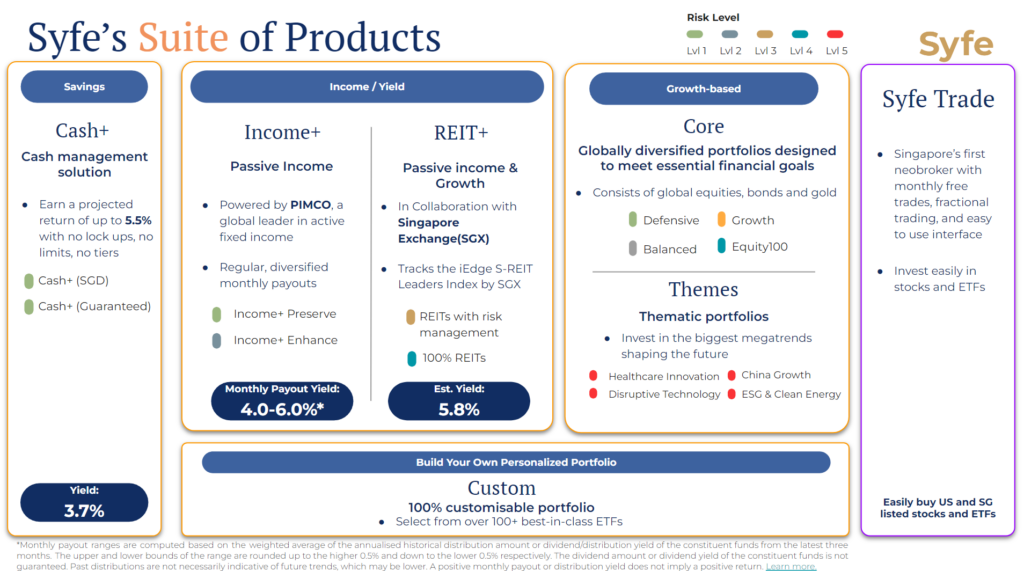
At Syfe, we believe that smarter investing can lead to better life outcomes. Our mission is to make institutional-level investment offerings accessible to everyone, at just a fraction of the cost charged by traditional institutions.
In this article, we will share more about our thinking and investment approach behind Syfe Core portfolios.
Table of Contents:
- Investment principles of the Core portfolios
- An Overview of Syfe’s four Core Portfolios
- How we built Syfe Core
- Asset class risk budgeting
- Smart beta
- Stable asset allocation
- Passive strategies, active ETF selection
- Getting started
Investment principles of the Core portfolios
At the heart of Syfe’s investment philosophy lie three pillars: diversification, cost-effectiveness, and a long-term vision. We are committed to playing the long game, and that is why our Core portfolios embrace a passive, enduring investment strategy.
Our core portfolios are globally diversified across asset classes, sectors, and geographies. Such diversification reduces risk while enhancing potential returns. We predominantly use index strategies to build these portfolios, ensuring minimal costs, transparent fees, and no hidden retrocessions. By prioritising cost-efficiency and aligning our strategies with our clients’ goals and risk tolerance, we aim for enduring returns. Built upon years of research, expertise, and experience, our investment approach is designed to stand the test of time.
An Overview of Syfe’s Four Core Portfolios
We offer four Core portfolios, designed to address some of the most important customer goals in life, from purchasing their first home to educating their children, and retiring comfortably.
Here’s a quick guide to help you understand which portfolio is right for you.
- Core Defensive is a low-risk portfolio that’s ideal for conservative investors, or those approaching a particular financial goal
- Core Balanced is a medium-risk portfolio that’s ideal for moderate investors with a mid-to long-term horizon
- Core Growth is a high-risk portfolio that’s ideal for growth-oriented investors with a longer time horizon
- Core Equity100 is a 100% equity portfolio that’s ideal for investors who are comfortable taking on higher risk for potential higher long-term returns
The key difference between each Core portfolio is their exposure to stocks and bonds, which in turn determines their overall risk level. Growth assets like equities offer higher return potential but come with more risk, while defensive assets like bonds provide stability with lower returns. Essentially, portfolios with more equities pose greater risks and potential rewards. This is why Core Defensive is our lowest risk portfolio and Core Equity100 is the highest, with the latter showing a higher average annual return than the former.

Choosing between the four Core portfolios very much depends on your investment goals, time horizon, and risk appetite.
How we built Syfe Core
Our portfolio methodology for Syfe Core rests on three guiding principles:
- Asset Class Risk Budgeting
- Smart Beta
- Stable asset allocation
Let’s delve into the details below.
Laying a foundation with Asset Class Risk Budgeting
Traditionally, asset allocation is thought of in terms of capital. If you have $1,000 and you allocate $600 to equities and $400 to bonds, you’ll have a classic 60/40 portfolio. Through periodic rebalancing, you’ll then strive to maintain this allocation of 60% equities and 40% bonds.
For our Syfe Core portfolios, we allocate portfolio weights using a process known as Asset Class Risk Budgeting – a risk-based method of portfolio allocation whereby the overall risk of the portfolio is distributed among various asset classes.
Risk budgeting is thinking about asset allocation in terms of risk. For instance, an investor does not earn a return from investing in stocks per se, but theoretically earns a return for assuming the various risks associated with a stock investment.
Different assets have different levels of risk; equities are more volatile than government bonds for example. With a risk budgeting approach, our investment team will optimise the portfolio weights of each asset class to meet the overall risk budget of the portfolio while seeking to achieve the maximum Sharpe Ratio possible.
Using Smart Beta to add robustness to Core
Another facet of our Core portfolio strategy is our use of Smart Beta factors to further optimise equity allocations.
The equity component of all Core portfolios takes into consideration the following factors: growth and value, volatility and emerging market(EM)exposure. These factors have been selected to generate better risk-adjusted returns.
Here’s a closer look at each Smart Beta factor.
- Growth & Value. While the growth factor remains relevant given the fundamental shift to greater technology adoption globally, the recent rotation to value should not be ignored. We tilt our equity selection to both growth and value stocks by including the tech-heavy Invesco QQQ ETF (QQQ) and the Invesco S&P 500® Equal Weight ETF (RSP). RSP adds exposure to smaller-cap and value stocks. Through QQQ and RSP, investors get access to stocks such as Apple, Microsoft, Eli Lilly and Co and Domino’s Pizza Inc.
- Low Volatility. The low-volatility tilt is achieved by using multiple sector ETFs – Consumer Staples, Healthcare, Technology and Utilities. These sectors have been chosen because they collectively generate the highest risk-adjusted returns for the lowest amount of volatility on a portfolio basis. Stock holdings include Procter & Gamble, Costco, Johnson & Johnson and NextEra Energy.
- EM exposure. The exposure to the EM factor is primarily through allocation to China and Chinese tech stocks. This factor is expressed using iShares MSCI China ETF (MCHI) and KraneShares CSI China Internet ETF (KWEB). These collectively provide exposure to some of China’s most important companies like Alibaba, Tencent, Pinduoduo and Meituan.
Stable asset allocation
With Core portfolios, investors will find that their asset allocation is relatively stable. This is because the portfolios utilise risk parameters that are calibrated for a longer term risk horizon to reduce short term portfolio reflexivity, i.e. short term asset allocation changes.
Passive strategies, active ETF selection
ETFs are the building blocks of Core portfolios. Compared to actively managed funds, ETFs provide a highly efficient, low cost and passive way to invest into the global markets.
While ETFs have been the poster childs of passive investing, traditional active fund managers have picked up on the trend by introducing index funds to capture a piece of this movement. Investors need to carefully evaluate index funds before investing as some can come embedded with much higher fees than their ETF counterparts.
Our process for selecting ETFs is rigorous. We do not endorse specific ETF brands or managers. Instead, our investment team selects ETFs based on their liquidity, low expense ratios, and minimal tracking errors relative to their benchmarks.
Getting started
Syfe Core portfolios have no minimum investment amounts and no lock-ins. You can set up as many Core portfolios as you prefer based on your goals. For example, you may invest in Core Growth for a long-term goal like retirement and choose Core Defensive for a shorter term goal such as a house downpayment. Ready to invest in Core portfolios?
You can pair our Core portfolios with other products we offer to meet your financial goals.
- For cash management, we offer Cash+ Flexi and Cash+ Guaranteed. Cash+ Flexi is ideal for your emergency funds, providing liquidity for unforeseen events with an expected rate of return at 3.7% p.a. On the other hand, Cash+ Guaranteed ensures both capital and return with a 3, 6 or 12-month lock-in period, boasting a current yield of 3.7% p.a
- If you are targeting income, consider our Income+ portfolios. Income+ portfolios, developed in partnership with PIMCO—a global leader in active fixed income, offer a monthly payout ranging from 4% to 6% p.a.
- For exposure to real estate, consider our REIT+ portfolios, which feature top Singaporean REITs.







You must be logged in to post a comment.